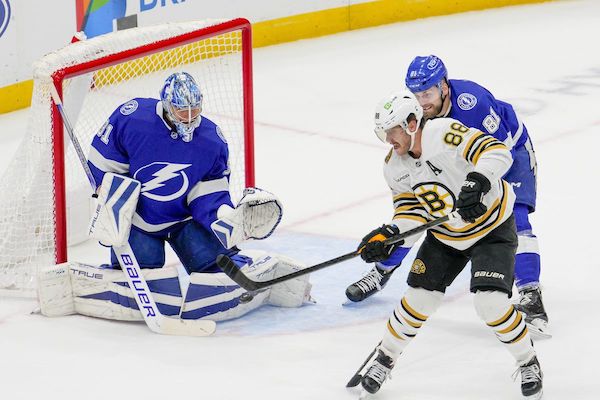
By: Max Weisman | Follow me on Twitter: @maweisman
One of the best ways to determine whether a hockey team is great is by looking at how the team responds after allowing a goal. During the last few games, the Bruins have been able to get punched in the mouth and respond. Let’s take a look at how they’ve been able to do that.
Against Detroit on December 31st, the Bruins took a 2-0 lead early in the second period but then let up a little, allowing the Red Wings to apply offensive pressure. This resulted in Detroit tying up the game in the span of three-and-a-half minutes, and the two teams headed into the third period tied at two.
However, the Bruins showed no signs of laying down and letting the Red Wings steal the win. Charlie Coyle scored early in the third, and Jeremy Swayman made timely saves before Jake DeBrusk scored the eventual game-winning goal on an empty netter. J.T. Compher scored to make it 4-3, but Pavel Zacha added a second empty netter for Boston. Swayman made ten saves on eleven shots in the third period to keep the Bruins from playing from behind, allowing them to keep pressure in the offensive zone.
Boston didn’t face much adversity in their next game in Columbus, but after allowing a tying goal in the second period, the Bruins, once again, stayed active. James van Riemsdyk scored in the second, while Danton Heinen and Trent Frederic added two in the third. Everyone on the Bruins was involved in the response, with Linus Ullmark making 13 saves after allowing his only goal of the game.
The game against Pittsburgh is an interesting case because while the result wasn’t what the Bruins wanted, the silver lining was that they showed perseverance. The game played out eerily like a game against Pittsburgh last year in which the Bruins staged a huge comeback. The Bruins fell behind 2-1 before David Pastrnak tied it up at 2, but the Penguins scored three goals to go up 5-2 early in the second period. Morgan Geekie, Jake DeBrusk, who’s starting to turn it on offensively, and Brad Marchand scored while the Bruins were shorthanded to tie the game at five. Unfortunately, Sidney Crosby scored seconds into a power play, and the Bruins couldn’t tie it back up. Boston put four more shots on goal and had plenty of scoring chances, but Penguins goalie Alex Nedeljkovic held firm, and Pittsburgh won 6-5.
Saturday against the Tampa Bay Lightning, the Bruins fell behind seconds into the game. However, they responded with three goals, including two from Trent Frederic, who has also been pouring on the offense lately. Nikita Kucherov made it 3-2, but David Pastrnak scored 30 seconds later to re-establish the Bruins two-goal lead. In a back-and-forth hockey game, Brayden Point scored his second of the night, but Morgan Geekie once again gave the Bruins their two-goal lead a minute-and-a-half into the third period.
Late in the third period, Tampa was gifted a power play and pulled Andrei Vasilevskiy for the two-man advantage. But Victor Hedman broke his stick on a shot attempt, and DeBrusk took the puck and scored the empty netter. Charlie Coyle then put the icing on the cake, adding the Extra Point on a breakaway. The Bruins won 7-3 in a statement third period.
Finally, on Monday in the Bruins’ 4-3 shootout loss to Colorado, they found themselves down 2-1 and 3-2 but were able to respond with the tying goal both times. Halfway through the second period, John Beecher tied the game at two. When the Avalanche retook the lead late in the second, Brad Marchand scored his second goal of the game to tie the game up again at three. While the Bruins ultimately fell in the shootout, they showed resilience and claimed a point from an excellent Avalanche team.
In these five games, the Bruins have repeatedly shown that they can and will respond to adversity, the mark of a great hockey team. Fighting for the top seed in the Eastern Conference, the Bruins will need to continue to show they can play a high level of hockey, which includes responding to opponents’ goals.


Leave a Reply